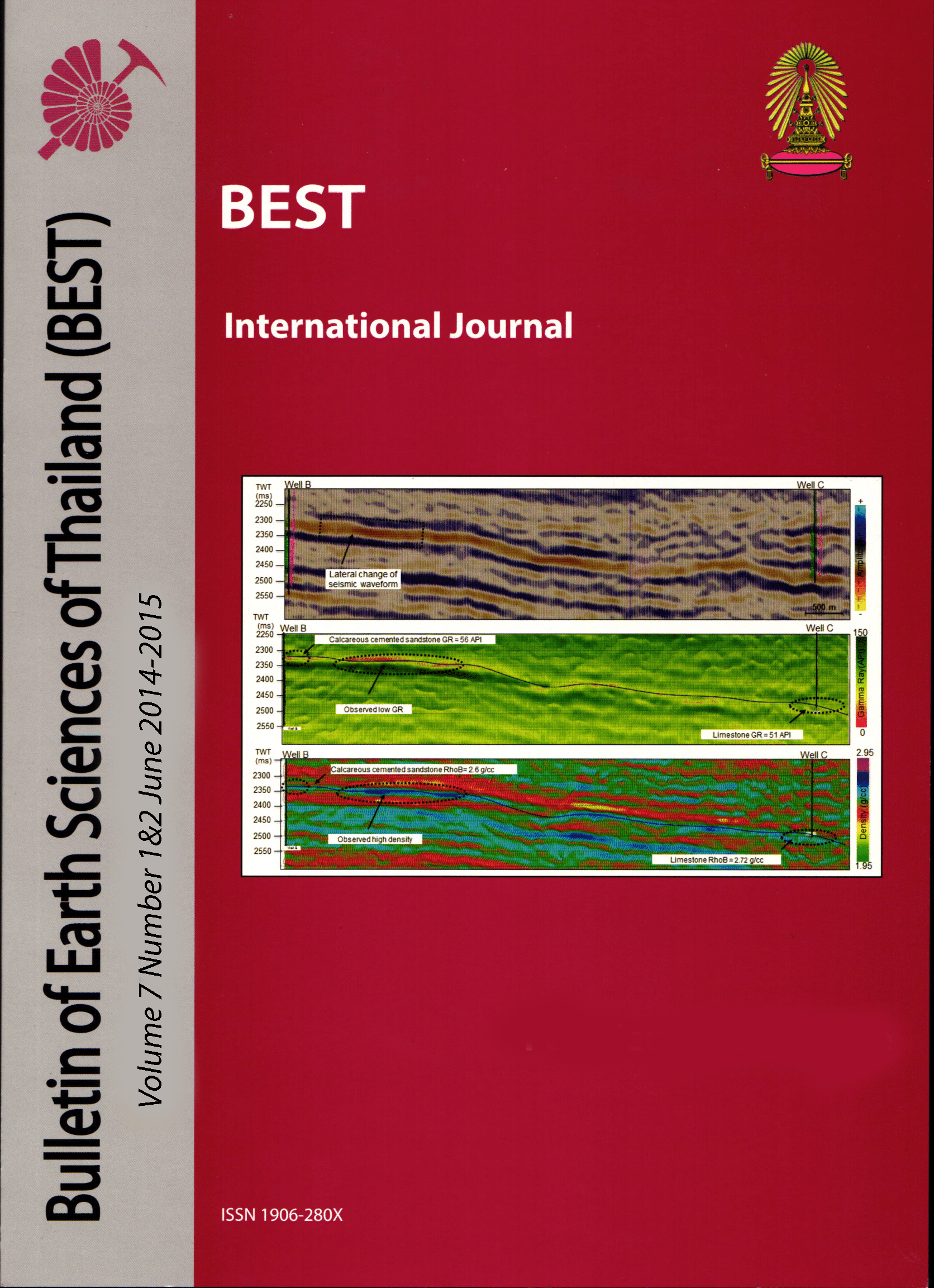AVO FEASIBILITY STUDY FOR HYDROCARBON DETECTION IN NORTHWESTERN PART OF THE PATTANI BASIN, GULF OF THAILAND
Main Article Content
Abstract
The Pattani Basin is one ofthe prolific areas for hydrocarbon exploration within the Gulf of Thailand. The main reservoirs of the area are Lower to Middle Miocene sands associated with fluvial depositional systems. Detection and quantification of hydrocarbon zones is not always accurate only by using conventional seismic amplitudes. I applied rockphysics and AVO technique on one of the hydrocarbon fields of the northern Pattani Basin to understand AVO response for different fluids and for different reservoir thicknesses. According to rock physics analysis, Pimpedance alone cannot successfully differentiatewater-wet and gassaturated sands. However, used in conjunction with Poisson's ratio it can separate gas-saturated sands. Similarly, cross-plot of Lambda-Rho vs Mu-Rho can also separates gas-saturatedzones. AVOmodeling reveals that most of the gas sands are class-III sands. Some of the gas sands and water-wetsands deviate from general predicted trend. The possible reasons for these deviations are 1) thickness of sandsis belowtuning thickness 2) Shales with very low Poisson's ratio over sand reservoirs. According to wedge modeling results, gas sands below tuningthickness do not show typical class III response. Presence of very low Poisson's ratio shales above the sand reservoirs may affect AVO response as AVO depends upon contrast of Poisson's ratio. AVO attribute analysis indicates that scaled Poisson's ratio change is more suitable to detect gas sands within this area. The sands greater than tuning thickness can be detected more effectively by AVO attributes as compared to thin sands. Extracted horizon slices of scaled Poisson's ratio can provide usefulinformationfor promising exploration zones, if analyzed with structure contour maps.
Article Details

This work is licensed under a Creative Commons Attribution-NonCommercial-NoDerivatives 4.0 International License.
Copyright © 2008 Department of Geology, Faculty of Science, Chulalongkorn University. Parts of an article can be photocopied or reproduced without prior written permission from the author(s), but due acknowledgments should be stated or cited accordingly.
References
Aki, K., and P.G. Richards, 1980, Quantitative Seismology, first edition: San Francisco, W.H. Freeman and Company, 557 p.
Avseth, P., T. Mukerji, and G. Mavko, 2005, Rock physics depth trends and anomalies in a North Sea field, Quantitative Seismic Interpretation: Cambridge, Cambridge University Press, p. 96-101.
Bachrach, R., and Avseth, P., 2008, Rock physics modeling of unconsolidated sands: Accounting for nonuniform contacts and heterogeneous stress fields in the effective media approximation with applications to hydrocarbon exploration: Geophysics, v. 73, no. 6, p. 197-209, doi 10.1190/1.2985821.
Barr, D.C., M.J., Flynn, C.S., Ong and K., Dhamarajan, 2011, Interpreting Geological Systems from Seismic Attributes: Reasons for Caution from the Northern Malay Basin: ITPC 14830, 2011 International Petroleum Technology Conference, 15-17 November, Bangkok, Thailand.
Castagna, J.P., and Smith, S.W., 1994, Comparison of AVO indicators A modeling study: Geophysics, v. 59, no. 12, p. 1849-1855, doi 10.1190/1.1443572.
Castagna, J.P., and Swan, H.W., 1997, Principles of AVO crossplotting: The Leading Edge, v. 16, no. 4, p. 337-344, doi 10.1190/1.1437626.
Castagna, J.P., Swan, H.W., and Foster, D. J., 1998, Framework for AVO gradient and intercept interpretation: Geophysics, v. 63, no. 3, p. 948-956, doi 10.1190/1.1444406.
Ghosh, D.M., Firdaus, A.H., Martin, B., Bernato, V., and Nasir, D., 2010, Geophysical issues and challenges in Malay and adjacent basins from an E & P perspective: The Leading Edge, v. 29, no. 4, p. 436-449, doi 10.1190/1.3378307.
Kamvan, J., 2013, Different types of organicrich geological markers in the sub-surface in the North Pailin field, Pattani basin, Gulf of Thailand, Master’s thesis, Chulalongkorn University, Thailand, 51 p.
Michel, L., H.H., Chee, R., Hampson, M.J., Flynn, H., Carigali, 2011, Application of PSDM Imaging for Reservoir Characterisation in the Northern Malay Basin: A Case Study: ITPC 1481, 2011 International Petroleum Technology Conference, 15-17 November, Bangkok, Thailand.
Morley, C.K., and A. Racey, 2011, Petroleum Geology, in M.F. Ridd, A.J. Baeber and M.J. Crow, eds., The Geology of Thailand: London, Geological Society, p. 351-392.
Morley, C.K., and A. Racey, 2011, Tertiary stratigraphy, in M.F. Ridd, A.J. Baeber and M.J. Crow, eds., The Geology of Thailand: London, Geological Society, p. 223-272.
Rutherford, S.R., and Williams, R. H., 1989, Amplitude-versus-offset variations in gas sands: Geophysics, v. 54, no. 6, p. 680- 688, doi 10.1190/1.1442696.
Sukitprapanon, P., 2010, The relationship between seismic amplitude, lithology and hydrocarbons in southern RIP block, Gulf of Thailand, Master’s thesis, Chulalongkorn University, Thailand, 141p.
Visadsri, P., 2013, Prediction of reservoir or sands by using rock physics and simultaneous inversion: Case study from the Pattani Basin, Gulf of Thailand, Master’s thesis, Chulalongkorn University, Thailand, 136 p.
Widess, M.B., 1973, How thin is a thin bed?: Geophysics, v. 38, p. 1176-1180.
Zoeppritz, K., 1919, Erdbedbnwellen VIIIB, on the reflection and propagation of seismic wave: Gottinger Nachrichten, v. 1, p. 66-84.


